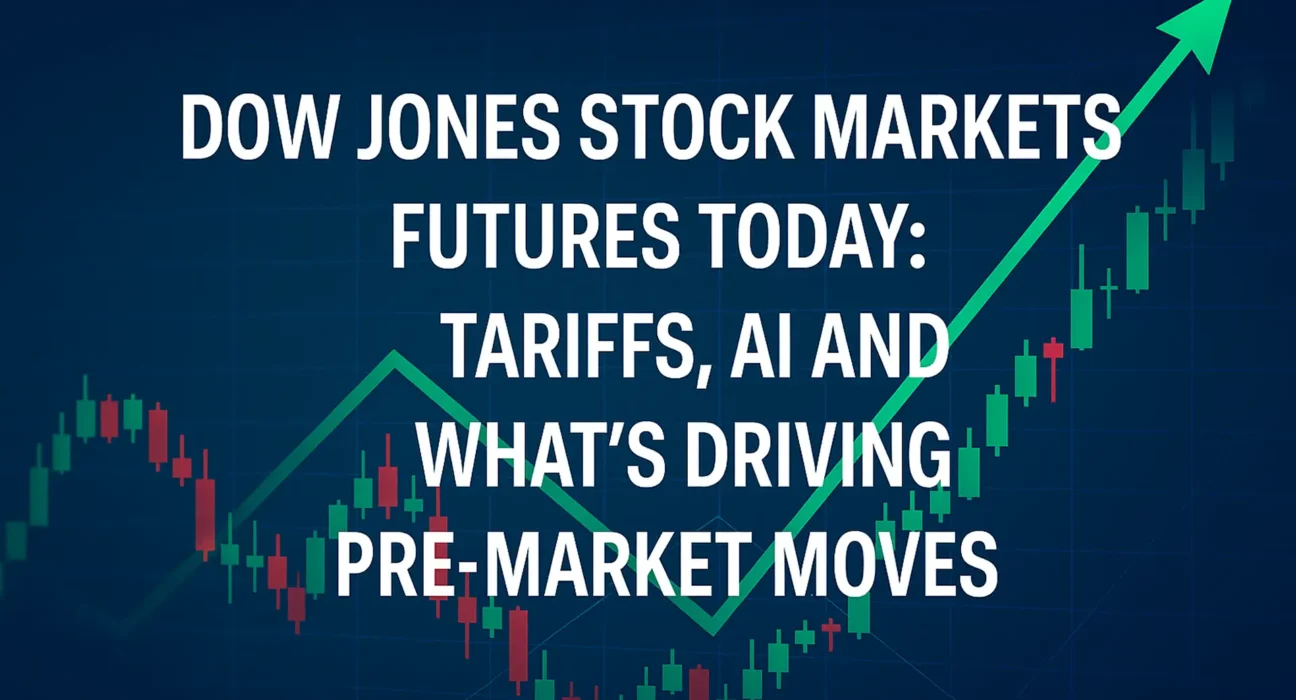The Dow Jones stock markets futures are buzzing today — but what’s causing all the noise? If you’ve ever stared at a pre-market ticker wondering why the heck the Dow is up (or down) before the bell even rings, you’re not alone. Today’s market movements are being shaped by a cocktail of global politics, groundbreaking technology, and good old-fashioned investor sentiment.
Let’s break it all down in plain English so you’re not left scratching your head.
What Are Dow Jones Stock Markets Futures, Anyway?
Before we dive deep, let’s clear the air. Dow Jones stock markets futures are contracts that predict the future value of the Dow Jones Industrial Average (DJIA). Think of them like a sneak peek into the stock market’s mood before the trading day officially begins.
They’re a tool for both traders and investors to gauge market sentiment and potentially hedge against losses. If futures are up, Wall Street’s feeling optimistic. If they’re down… well, you get the idea.
Today’s Big Movers in the Dow Jones Futures
Tech Giants on the Rise — Thanks, AI
Artificial Intelligence is doing more than writing essays and generating images — it’s fueling massive gains in companies like Microsoft, NVIDIA, and Apple. As these titans embrace AI, investors are piling in, driving Dow Jones Futures upward in anticipation of even bigger profits.
Tariff Troubles Stir the Pot
Fresh tariff talk between the U.S. and China has thrown a wrench in things. Whenever the word “tariff” makes headlines, markets get nervous. Today, discussions of increasing trade barriers on electric vehicles and semiconductor components are sending shockwaves through manufacturing stocks.
Why Pre-Market Moves Matter
Let’s face it — nobody likes surprises. Especially not Wall Street. Pre-market futures help smooth out the ride by setting expectations. When Dow Jones Futures surge, traders may prepare for a bullish open. When they slump, everyone braces for impact.
Tariffs and Trade: The Domino Effect on the Dow
How Global Policies Rattle the Index
The Dow Jones isn’t just about American companies. These businesses operate globally, and when international relationships get rocky (like today’s tariff threats), it affects earnings, supply chains, and ultimately — stock prices.
Case in Point — Boeing and Caterpillar
Both are Dow components. Both rely heavily on international trade. News of potential tariffs has sent their pre-market futures wobbling, contributing to today’s Dow jitters.
AI: Not Just a Buzzword, But a Market Mover
AI has evolved from sci-fi fantasy to economic engine. Tech-heavy Dow companies like IBM and Intel are betting big on AI — and so are investors.
H3: Chip Stocks Fuel the Fire
Look at Dow Jones stock markets and you’ll see chipmakers glowing green today. NVIDIA and AMD (though not in the Dow, they impact sentiment) are climbing thanks to optimistic AI-driven earnings reports.
Software Takes Center Stage
Cloud-based platforms using AI for enterprise solutions are seeing positive futures movement. Microsoft’s OpenAI partnership? Still a major catalyst.
What Analysts Are Saying Today
Most Wall Street analysts are cautiously optimistic. The AI momentum is hard to ignore, but tariff uncertainty has tempered the enthusiasm.
JP Morgan notes that “the market is pricing in aggressive AI growth,” while Goldman Sachs warns that “macro events like tariffs can quickly offset sector-specific gains.”
Economic Reports Expected Today
Here’s what’s scheduled to drop today and potentially shake up the Dow Jones Futures again:
- Consumer Price Index (CPI): Inflation numbers could turn the tide.
- Unemployment Claims: A dip might fuel confidence.
- Fed Minutes: Everyone’s listening closely for any rate hike hints.
Pre-Market Winners and Losers
Big Winners:
- Microsoft – Up on continued AI momentum
- Intel – Gains due to chip expansion in Europe
- 3M – Surprise earnings beat leaked pre-market
Not-So-Lucky:
- Caterpillar – Down on trade war fears
- Nike – Lower global consumer demand forecast
- Walmart – Facing supply chain disruptions
Investor Sentiment — Fear or FOMO?
It’s a mixed bag today. Some investors are terrified of geopolitical risks. Others don’t want to miss the AI wave.
This emotional tug-of-war is exactly why Dow Jones stock markets futures can fluctuate so rapidly. News drops. Opinions shift. And futures ride the roller coaster.
How You Can Interpret These Futures as a Retail Investor
No, you don’t need to be a hedge fund manager to understand futures. You just need to look at them as a market thermometer.
If you see Dow Jones Futures are up before open, that’s like checking the weather and seeing “sunny with a chance of gains.” But don’t forget to pack an umbrella — news can flip in an instant.
Are Dow Jones Futures a Reliable Indicator?
Kind of. They’re a good snapshot of current sentiment, but they’re not a crystal ball. Futures often change course based on news, earnings, or global drama.
Use them in your toolkit, but don’t rely on them alone. Look at broader trends, analyst forecasts, and market indicators.
Also Read this: Amazon Prime Day 2025: Tech Steals & Smart Savings You Can’t Miss
What This Means for Long-Term Investors
If you’re a long-hauler, today’s Dow Jones stock markets futures may not matter much — but the underlying trends should.
- AI isn’t going away
- Tariff risk is real
- Global instability can whipsaw the market
So diversify, stay informed, and remember: it’s a marathon, not a sprint.
The Bottom Line
Today’s Dow Jones stock markets futures reflect a classic tug-of-war between innovation and instability. AI is lighting up Wall Street like a fireworks show, but tariffs and trade tensions are like surprise summer storms.
Whether you’re a trader looking for quick wins or an investor with your eyes on the horizon, keep your seatbelt fastened — and your portfolio flexible.
FAQs
1. What time do Dow Jones futures start trading?
Dow Jones futures start trading Sunday at 6:00 p.m. ET and run nearly 24/7 through Friday evening, pausing briefly each day from 5:00–6:00 p.m.
2. Can regular investors trade Dow Jones futures?
Yes, but it’s risky. Futures trading isn’t for the faint of heart. You’ll need a brokerage account that supports futures and should understand the risks involved.
3. How do AI trends influence the Dow?
Companies in the Dow like Microsoft and IBM are heavily invested in AI. When AI outlooks are positive, their stock prices — and the Dow overall — often rise.
4. What are the biggest risks to Dow Jones futures today?
Tariffs, inflation data, and interest rate expectations are the top risks right now. Any major news in these areas can cause big swings.
5. Is it smart to make trading decisions based on pre-market futures?
It can offer insights, but don’t rely on them exclusively. Combine futures with market news, earnings reports, and economic indicators.
6. Why is the Dow different from the S&P 500 or Nasdaq?
The Dow is price-weighted and includes 30 industrial giants. The S&P 500 is broader, and the Nasdaq is more tech-focused. Different index, different behavior.





